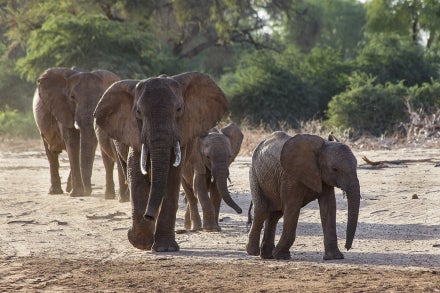Image

An international team of the world’s leading reproductive and genetic experts will meet December 3-6, 2015 in Vienna, with the purpose of fighting extinction. The meeting, organized by the Leibniz Institute for Zoo and Wildlife Research (IZW) in Germany, San Diego Zoo Global in the United States, Tiergarten Schönbrunn in Austria and ZOO Dvůr Králové of the Czech Republic, will include scientists from four continents. The goal of the meeting will be to set up a master plan to save the northern white rhino, a species on the brink of extinction.
Only three individuals remain after the death of Nola, a 41-year-old northern white rhinoceros (Ceratotherium simum cottoni) at the San Diego Zoo Safari Park on November 22, and Nabiré, a 32-year-old female at ZOO Dvůr Králové on July 27, 2015. The last three individuals, a male and two females, presently live at Ol Pejeta Conservacy in Kenya. Age and reproductive challenges make the possibility of natural reproduction unlikely, but the DNA of a dozen individual northern white rhinos has been preserved in genetic banks in Berlin and San Diego. The experts hope to use this genetic information to bring back the species.
Leading scientists will use their broad spectrum of expertise to rescue the last northern white rhinos by joining forces. They will discuss possible options and come up with an international rescue plan that will hopefully save the northern white rhinos, and may help to save other species as well. Options that have been brought up during preliminary discussions include sperm and egg generation from other cell types, laboratory egg fertilization and embryo culture, and the use of the closely related southern white rhinoceros (Ceratotherium simum simum) as surrogates.
One special focus will concentrate on the development of cellular techniques for conservation. This new approach is an essential, promising option for highly endangered wildlife. For this purpose, the world's leading scientists in the field of cellular techniques will discuss new methods of securing and preserving wildlife tissue samples.
The international rescue meeting will have a net zero carbon footprint.
The Leibniz Institute for Zoo & Wildlife Research (IZW) is an internationally renowned research institute of the Leibniz Association. With the mission of "understanding and improving adaptability," it examines evolutionary adaptations of wildlife and its resilience to global change, and develops new concepts and measures for conservation. To achieve this, the IZW uses its broad interdisciplinary expertise in evolutionary ecology and genetics, wildlife diseases, reproductive biology and management in a close dialogue with stakeholders and the public.
www.leibniz-izw.de
Founded in 1752, Schönbrunn Zoo in Vienna is the oldest zoo in the world. In a unique combination of protected monument and modern zoo biology, it is home to more than 700 animal species, including rare giant pandas. Four times in succession, the Schönbrunn Zoo received an award as the best zoo in Europe. This unique zoo is scientifically managed and its mission is to interest visitors in the world of animals, and to enhance their awareness for the conservation of threatened wildlife species. Schönbrunn Zoo is not just a place for recreation and to come to see animals, it is also an educational center, a site for research and teaching, and a strong partner in nature and species conservation projects.
www.zoovienna.at
Bringing species back from the brink of extinction is the goal of San Diego Zoo Global. As a leader in conservation, the work of San Diego Zoo Global includes on-site wildlife conservation efforts (representing both plants and animals) at the San Diego Zoo, San Diego Zoo Safari Park, and San Diego Zoo Institute for Conservation Research, as well as international field programs on six continents. The work of these entities is made accessible to children through the San Diego Zoo Kids network, reaching out through the Internet and in children’s hospitals nationwide. The work of San Diego Zoo Global is made possible by the San Diego Zoo Global Wildlife Conservancy and is supported in part by the Foundation of San Diego Zoo Global.
www.sandiegozooglobal.org/overview
ZOO Dvůr Králové has been one of the most important breeders of African ungulates in the world since the late 1970s. The zoo is dedicated to conserving African wildlife through both ex situ and in situ efforts, as well as promoting African culture and wildlife conservation. Four northern white rhinos have been born in the zoo; and in 2009, it collaborated with its partners to transfer the four northern white rhinos from Dvůr Králové to Ol Pejeta Conservancy, Kenya, in hope to further prompt their breeding.
www.zoodvurkralove.cz/en/
CONTACT: SAN DIEGO ZOO GLOBAL PUBLIC RELATIONS, 619-685-3291




